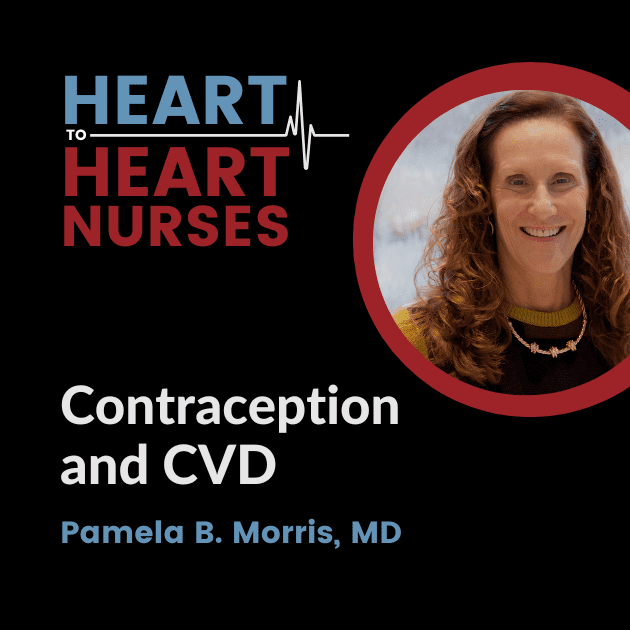Pamela B. Morris, MD describes women and CVD and the relationship to contraception. Learn the role of cardiovascular professionals in pre-pregnancy counseling, partnering with OB/GYN colleagues to maximize the cardiovascular health of patients, and the impacts of various contraception types on cardiovascular health.
Episode Resources
- U.S. Contraception App (MECUSSPR)
Welcome to Heart to Heart Nurses, brought to you by the Preventive Cardiovascular Nurses Association. PCNA’s mission is to promote nurses as leaders in cardiovascular disease prevention and management.
Geralyn Warfield (host): Thank you very much to our audience for joining us today, where we’re going to be speaking about women and CVD and the relationship to contraception. Today, I have the great honor of speaking with Dr. Pamela Morris. And I’m going to go ahead and let her introduce herself to you.
Pamela Morris (guest): Great. Well, thank you so much for having me. I’m Dr. Pam Morris. I am a Professor of Medicine in Cardiology at the Medical University of South Carolina in Charleston.
Geralyn Warfield (host): Well, we are so grateful to you for sharing your time with us today. Why don’t we go ahead and dive in and talk a little bit about the role of a cardiovascular clinician in pre-pregnancy counseling?
Pamela Morris (guest): Well, it’s, it’s very interesting in all the years of my [00:01:00] career. I think that my, my personal level of awareness of the importance of counseling in contraception has not always been heightened to the level that it is now. You know, are we beginning to learn more and more about unique cardiovascular risk factors in women and certainly things in, you know, pregnancy, adverse pregnancy outcomes, that sort of thing.
And now we’re beginning to really increase all our level of awareness of the importance of considerations in contraception for women with cardiovascular disease, or at risk of cardiovascular disease. And there’s so many different forms of contraception. And when we are seeing our patients, we need to be able to have an open dialogue with them about what the types of contraception [00:02:00] are, and what the pros and cons may be for them. And that counseling needs to begin at our very first visit with an at-risk woman. We need to begin discussing pregnancy planning, conception planning, with them from the very outset.
The current recommendations are that for any woman with congenital heart disease or cardiovascular disease, contraceptive at pregnancy planning discussion should occur at every visit between the ages of 15 and 44. So really important consideration.
Geralyn Warfield (host): So, there’s a big team effort between you and the patient, obviously, as you’re having these discussions and making recommendations on the part of the clinician and, you know, providing information from the part of the patient. But I suspect this team effort goes far beyond that relationship that I’ve just [00:03:00] described.
Pamela Morris (guest): You know, that’s correct. And I think that for most of us as cardiovascular clinicians, we, we have quite a bit on our plate when we’re seeing our female patients, you know, whether it’s management of hypertension, management of diabetes, lipid disorders, etc. And, and if they’re, if they are a cardiovascular patient, it may be congenital heart disease. It may be prior venous thromboembolism, maybe a pulmonary embolus or DVT.
So, we have a lot on our plate. And to then add to that pre-pregnancy planning and contraceptive planning is kind of a lot to ask. And also a lot to ask to be familiar with the numerous options in contraception.
So that makes it incredibly important that in addition to the cardiovascular clinician and the patient, we need to be sure to have an [00:04:00] OB/GYN member of the team. And, in particular, an OB/GYN expert who is comfortable with caring for medically complex patients, because these cardiovascular patients are going to be medically complex.
And so, that’s really what the team should look like. Now, of course, we also want to include primary care, whether that is an advanced practice professional, or family practice professional. Regardless, that’s what the team needs to look like for a patient.
Geralyn Warfield (host): So, in your particular practice, what does that OB/GYN teammate look like in terms of relationship to what you have going on? Do you have a particular OB/GYN with whom you communicate on a regular basis? Or how, how does that look?
Pamela Morris (guest): So, it, it looks different for every patient to be honest. So, in my particular program, I don’t have a designated, specific OB/GYN [00:05:00] to which we refer. And in fact, you know, we get referrals from all over the state. And so there may be a variety of professionals.
But what, the important thing about the patient’s care is communication. So, what I’ve established is a guaranteed relationship of forwarding my notes, referrals (particularly for any medically complex patient) to be sure that that OB/GYN and primary care professional are also included and, and made aware of my concerns.
Now, certainly, you know, many of us in, I would imagine some of your listeners are preventive specialists. And some of our women will come to us and they are not complicated. They, they want a prevention perspective. They want to be screened for cardiovascular risk, but in fact, they’re doing well and there are no specific cardiovascular concerns. [00:06:00] In those patients, I may not get involved, or I may forward my note and say, “I have no specific concerns relevant to contraceptive therapy.” But when there are concerns, I do make sure that communication is forwarded.
Geralyn Warfield (host): It’s a wonderful idea to have that clear communication, and to build those relationships with those other care professionals who can support the patients in their, their goals and in their objectives as well.
Pamela Morris (guest): Correct.
Geralyn Warfield (host): We’re going to take a brief break and be right back with Dr. Pamela Morris.
Geralyn Warfield (host): We’re back with Dr. Pamela Morris. Who’s speaking with us today about the links between cardiovascular disease and contraception. And I have another question for you, Dr. Morris, and it has to do with the pros and cons of various contraceptive types. Now you could probably teach a semester-long course about this because it’s quite a complicated effort if you are looking at the whole variety [00:07:00] of contraceptives that are out there. What could you tell our listeners today to give them a broad perspective—or more specific as you desire?
Pamela Morris (guest): Well, I think importantly, just to have a broad overview, there are, there are three ways that we think about oral contraceptives. The first category I would consider are those which are hormonal versus non-hormonal. So is, is either a progestin and/or an estrogen involved in the therapy.
The second way to think about is, is the therapy reversible or is it permanent. So permanent: sterilization, for example.
And the final way to think about it is whether or not, or the failure rate—the effectiveness of—the therapy. So, there are three tiers of effectiveness. So, when I go over contraception with a woman, I want to put all of those considerations in play. The [00:08:00] hormonal component of it can be particularly important because it can, if there is an estrogen component to it, there may be an increased risk of venous thromboembolism.
So, let’s just think about hormonal contraception first. So, all of the therapies include a progestin agent. And the progestin agent is really what is playing a role in terms of preventing pregnancy. So these, the progestins prevent ovulation. So, it suppresses the gonadotropin-releasing hormone. It reduces LH. It also has an effect on sperm viability with, with sexual activity. So that’s the role of the [00:09:00] progestin.
The role of the estrogen is really to affect bleeding associated with the progestational agents. So, including an estrogen component can give more reliable or more predictable bleeding with the contraception. But it’s also the estrogen component that increases the risk of venous thromboembolism. And so, you know, all of the different preparations, regardless of how you use them, if they include an estrogen—which most frequently that’s going to be ethinyl estradiol—they are metabolized through the liver and can activate the hemostatic system. So that’s really important to consider.
Now again, when we consider reversible versus, versus permanent, obviously the two types of permanent sterilization will be either female sterilization, which is a tubal ligation, tubal [00:10:00] sterilization, or for men (which is no risk to the woman) is permanent male sterilization, which in medically complex patients, that may be a preferred option, but we do have other options that are safe for patients.
And then the final way are the three tiers of effectiveness. Some of these contraceptive methods have a less than 1% failure. So that’s great, particularly for, for someone who has a low risk tolerance for pregnancy. Others are in the range of 12 to 18% or so, and then there are other forms that are 18 to 28% failure rate. So, we need to keep that in mind when we’re discussing contraceptives with therapy with women.
Geralyn Warfield (host): I really appreciate all the breadth of information that you have shared with us today. Are there particular resources that you would ask if a clinician came to you and said, “I would like more information”? Are there particular places that you would point them [00:11:00] towards?
Pamela Morris (guest): Definitely. So there, let’s just talk about a clinically useful point-of-care resource. I would recommend that your listeners download the app. It’s called the US MECUSSPR or just US MEC is how it comes up either in the App store or in Google Apps, comes right up. That is so convenient because it lets you look at your patient’s medical conditions. For example, things like migraine headaches, hypertension, diabetes, obesity, history of DVT. You can go in and by condition, it will give you a rating of the safety for your patient of all of the various forms of contraception.
And I use that in my practice because it’s a convenient way to, right [00:12:00] at the point of care, go over with the patient where the concerns are going to be.
Now you can also access the US Medical Eligibility Criteria and Selected Practice Recommendations online through the CDC. So, through the CDC’s website, you can access them on your computer as well. And it is a great, useful resource.
Geralyn Warfield (host): Well, you have provided us with a plethora of information for us to take in and to address with our patients who are pregnant or are planning to be, or not to be pregnant, and really allowed us to see the breadth of information that’s available to us as clinicians that we can use at point-of-care. Is there anything else that you would like to add that I’ve neglected to ask about today?
Pamela Morris (guest): No. Just please be sure to familiar, familiarize yourself with the contraceptive therapies, have that app available to you in [00:13:00] clinic. And build a team, so that we can provide the best possible multidisciplinary care for our female patients during their reproductive years.
Geralyn Warfield (host): Dr. Morris, thank you so very much for joining us today. This is Geralyn Warfield, your host, and we’ll see you soon. Thank you for listening to heart, to heart nurses.
We invite you to visit pcna.net for clinical resources, continuing education, and much more.
Thank you for listening to Heart to Heart Nurses. We invite you to visit pcna.net for clinical resources, continuing education, and much more
Topics
- Women and Heart Disease
Published on
January 31, 2023
Listen on:
MD, FACC, FAHA, FASPC, FNLA
Related Resources
Sorry, we couldn't find any resources.






